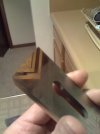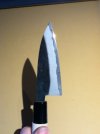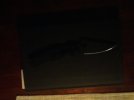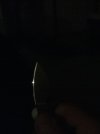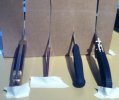Heyyyyyyy ! A fellow Woodworker . . . Greetings !
To answer your question . . .
. . . . well before I do I want to say I am not saying you shouldn’t use the Sharpmaker. Enjoy it; it’s good stuff.
. . . there . . . now onward !
I find that if I use a great sharpening jig that anything I put in that sucker turns out equally super / still blows me away SHARP. How sharp ? Well the locals here are just sick of hearing me say it but :
Picture a single hair on your arm firmly rooted and happy.
Picture taking the freshly sharpened edge off the last stone ( NO STROPS ) and carving little curls off the same hair repeatedly. I use a jeweler's visor to view this.
I realize there are sharper things on the planet but . . . heck . . . that’s good enough for this bozo.
What does that edge look like ? See photo below. That’s off a Varitas jig and Shapton Pro water stones (an A2 Steel alloy) but with diamond plates the same thing happens on the high vanadium alloys such as S110V, S90V etc. I find it easier to photograph the polish on the flat planes of the plane blade than my knives and the polished area on the knives is way, way smaller; often just a half millimeter or so right at the edge still . . . same goes for the knives (I like a precision bevel and polished to 8,000 Shapton Pro or 4,000 Shapton Glass or 8,000 diamond stone (on the Edge Pro).
For knives I use an Edge Pro Apex.
As far as what comes up nice after use and a free hand touch up and what I use for the freehand touch up . . .
the most surprising experience I have had so far (and the blade was already sharpened on the Edge Pro and then used) . . . the edge was near shave sharp sorta and I wanted to get it back to at least shave sharp.
The blade was Spyderco M4 alloy and the stone I used to touch it up free hand (no holder) was the Spyderco Ultra Fine triangle rod for the Sharpmaker. That blade became tree topping sharp; I noticed it as I started to try to shave and it was cutting the tops of the hair before I could get it down on my skin.
In short : Me Likey !
Still though anything I were to put on the Edge Pro for a few passes would have come up about the same in about the same amount of time. I just lucked out that the M4 liked the ceramic sharpening rod and that the edge wasn't too far gone to respond.
And lastly for steel that I just like with out too much logical thought put into it . . . that just feels great to me in use and sharpening, that would be Hitachi White Paper steel. Probably what is in some of your laminated Japanese chisels. Those are superior aren't they . . . mostly I dare say . . . due to the much better heat treat and temper compared to the western BS they pass off as woodworking tools these days.
WARNING : too many photos ahead >>>>
View attachment 843781
View attachment 843782
View attachment 843789
View attachment 843802
View attachment 843803
View attachment 843804
View attachment 843805


